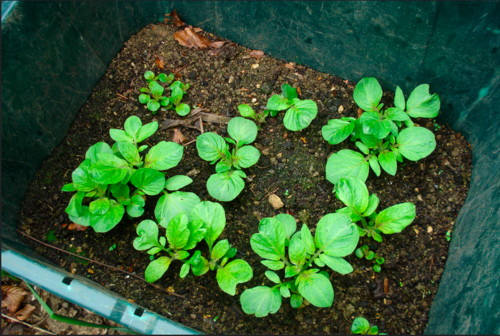
Potatoes (Solanum tuberosum) can be grown in many different places but for ease of access and tending, growing them in containers is a useful way to keep them. This is suitable for people with limited garden space, for the elderly or those who find digging difficult.
Seed potatoes[edit | edit source]
As well as a suitable container, you'll also need seed potatoes. Seed potatoes should have eyes in them, ready to sprout (chit potatoes). Arrange these in a container, such as an egg box, the eyes facing upward.[1] Set aside in an area with good light and ventilation, such as a cool windowsill. Leave until they sprout, anywhere between 4 and 6 weeks. Once they have sprouts, the seed potatoes are ready for planting.
It's recommended that you purchase or source seed potatoes instead of using leftovers from the vegetable cooler, as then you can be reassured that they are virus-free. Seed potatoes can be chosen from early, early main and main. You'll need to select the type according to your needs.
Selecting the container[edit | edit source]
Large plastic containers or flexible plastic storage tubs make an ideal growing container. Even better if they have handles, as this makes it easy to move the container around. Other plastic containers include plastic barrels, dustbins,[1] woven polypropylene containers or large plastic bags. Even large plastic buckets can work well, for a single or pair of potatoes.
If growing several potato plants at once, the container size should be around 45 to 75 litres (12 to 20 gallons). For a single or pair of potato plants, a smaller container or bag will work just fine.
The container should be strong and capable of having drainage holes pushed through it. Prepare the container by drilling several holes in the bottom, to allow for drainage. Use a small item such as a drill or a pointed tool to make the holes; the holes should be small, to prevent the soil from falling out. A circle of holes is fine, around the edge of the container's base.
Growing potatoes in the plastic container[edit | edit source]
Select suitable soil mix for the container. It should contain well-rotted compost as well as soil. Well-rotted manure is another alternative.
Pour a third of the soil into the container.
Place the seed potatoes into the container, on top of the soil already added. They should be spaced away from the sides of the container, by about 7.5cm (3 inches). Keep a good distance between each seed potato.
Add enough soil to cover the potatoes. There is no need to add more at this stage, as you'll be "earthing up" as the potatoes grow.
As the potatoes grow, continue adding more soil when the shoots emerge through the earth. This encourages many tubers to appear along the stems, which increases yield. It also prevents the tubers from turning poisonous.[1] Always leave the leaves out of the soil. Finish adding soil about 5cm (2 inches) from the top of the container.
Caring for the tub potatoes[edit | edit source]
Water generously and regularly without overwatering. The supply of water must be reliable for a good harvest.[1] Keep in a sunny and warm place. It's okay to move the containers around if needed.
Harvesting the potatoes[edit | edit source]
Allow the potatoes to flower. This stage adds some colour and prettiness to your container garden collection. The potatoes are ready for harvesting when the foliage dies back.
You can harvest some or all of the potatoes. If harvesting all of them at once, tip them out of the container. If harvesting a few, dig out what is needed and leave the rest to be unearthed later when needed.
For growing potatoes in the container again, remove the soil and clean the container with hot, soapy water. Add completely new soil to the container. This will keep the container and soil virus free for the next crop of potatoes.
Tips[edit | edit source]
- Hessian (burlap) sacks can be used in place of plastic containers or bags.[1]
Sources and citations[edit | edit source]
- Royal Horticultural Society, (2013) Grow Fruit & Veg in Pots, ISBN 978-1-4095-2338-9